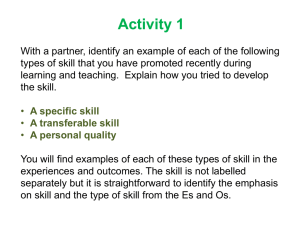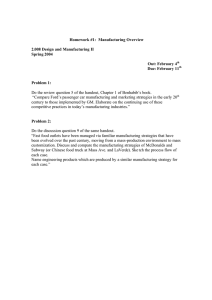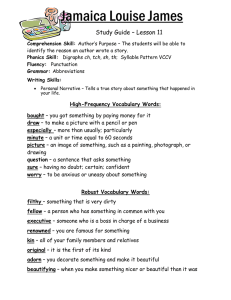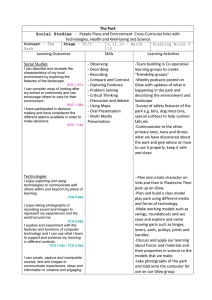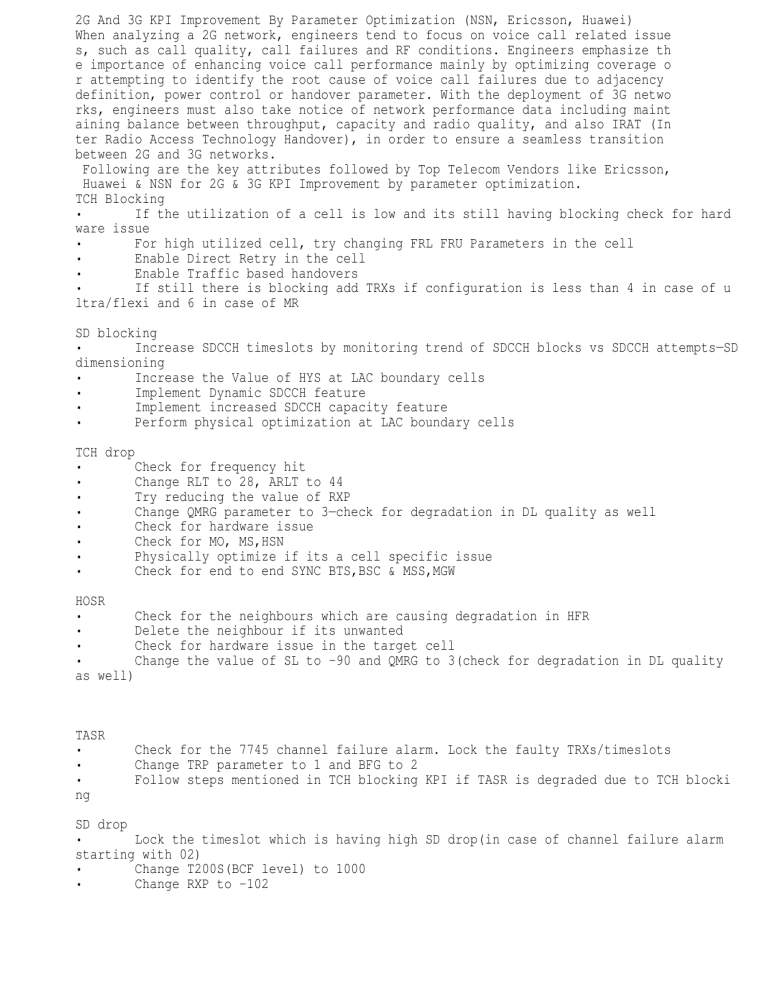
2G And 3G KPI Improvement By Parameter Optimization (NSN, Ericsson, Huawei) When analyzing a 2G network, engineers tend to focus on voice call related issue s, such as call quality, call failures and RF conditions. Engineers emphasize th e importance of enhancing voice call performance mainly by optimizing coverage o r attempting to identify the root cause of voice call failures due to adjacency definition, power control or handover parameter. With the deployment of 3G netwo rks, engineers must also take notice of network performance data including maint aining balance between throughput, capacity and radio quality, and also IRAT (In ter Radio Access Technology Handover), in order to ensure a seamless transition between 2G and 3G networks. Following are the key attributes followed by Top Telecom Vendors like Ericsson, Huawei & NSN for 2G & 3G KPI Improvement by parameter optimization. TCH Blocking • If the utilization of a cell is low and its still having blocking check for hard ware issue • For high utilized cell, try changing FRL FRU Parameters in the cell • Enable Direct Retry in the cell • Enable Traffic based handovers • If still there is blocking add TRXs if configuration is less than 4 in case of u ltra/flexi and 6 in case of MR SD blocking • Increase SDCCH timeslots by monitoring trend of SDCCH blocks vs SDCCH attempts—SD dimensioning • Increase the Value of HYS at LAC boundary cells • Implement Dynamic SDCCH feature • Implement increased SDCCH capacity feature • Perform physical optimization at LAC boundary cells TCH drop • Check for frequency hit • Change RLT to 28, ARLT to 44 • Try reducing the value of RXP • Change QMRG parameter to 3—check for degradation in DL quality as well • Check for hardware issue • Check for MO, MS,HSN • Physically optimize if its a cell specific issue • Check for end to end SYNC BTS,BSC & MSS,MGW HOSR • Check for the neighbours which are causing degradation in HFR • Delete the neighbour if its unwanted • Check for hardware issue in the target cell • Change the value of SL to -90 and QMRG to 3(check for degradation in DL quality as well) TASR • • • ng Check for the 7745 channel failure alarm. Lock the faulty TRXs/timeslots Change TRP parameter to 1 and BFG to 2 Follow steps mentioned in TCH blocking KPI if TASR is degraded due to TCH blocki SD drop • Lock the timeslot which is having high SD drop(in case of channel failure alarm starting with 02) • Change T200S(BCF level) to 1000 • Change RXP to -102 Paging Success Rate • • In case of high paging load, perform LAC splitting Change AT (Repaging attempts)=2, INT(Repaging interval)=500 ms ****************************************************************** ****************************************************************** How to reduce Call Drops In a GSM Network posted Oct 13, 2009, 12:53 AM by Gulzar Singh [ updated May 9, 2011, 1:13 PM ] Meaning The TCH call drop rate refers to the ratio of call drops to successful TCH seizu res after the BSC successfully assigns TCHs to MSs. The TCH call drop rate can b e measured from the following aspects: TCH call drop rate (including handover) TCH call drop rate (excluding handover) The TCH call drop rate, one of the most significant KPIs for telecom operators, is related to retainability. It indicates the probability of call drops due to various reasons after MSs access TCHs. A too high TCH call drop rate adversely a ffects the user's experience. Recommended Formulas TCH call drop rate (including handover) = Number of call drops on TCH/(Number of successful TCH seizures (signaling channel) + Number of successful TCH seizures (TCH) + Number of successful TCH Seizures in TCH handovers (TCH)) x 100% TCH call drop rate (excluding handover) = Number of call drops on TCH/Number of successful TCH seizures (TCH) x 100% Factors That Affect the TCH Call Drop Rate According to user complaints and network optimization experience, the major fact ors that affect the TCH call drop rate are as follows: Hardware failure Transmission problem Version upgrade Parameter setting Intra-network and inter-network interference Coverage problem Antenna system problem Imbalance between uplink and downlink Repeater problem 1.1 Hardware Failure When a TRX or a combiner is faulty, seizing the TCH becomes difficult, and thus the TCH call drop rate increases. 1.2 Transmission Problem The TCH call drop rate increases in the following conditions: The transmission quality on the A or Abis interface is poor for various reason s. Transmission links are unstable. 1.3 Version Upgrade After the BTS version or BSC version is upgraded, the BTS version may be incompa tible with the BSC version, and the parameters and algorithms in the new version may be changed. In this case, the TCH call drop rate increases. 1.4 Parameter Setting The settings of some parameters on the BSC and MSC sides may affect the TCH call drop rate. If the following situations occur, the TCH call drop rate may increa se: 1. The parameters SACCH Multi-Frames and Radio Link Timeout are set to t oo small values. 2. The parameter RXLEV_ACCESS_MIN is set to a too small value. 3. The parameter RACH Min.Access Level is set to a too small value. 4. The parameters Min DL Power on HO Candidate Cell and Min Access Level Offset are inappropriately set. 5. The length of timer T3103 (this timer is set to wait for a Handover C omplete message) is set to a too small value. 6. The length of timer T3109 (this timer is set to wait for a Release In dication message) is set to a too small value. 7. The length of timer T3111 (this timer specifies the connection releas e delay) is set to a too small value. 8. The length of timer T305/T308 is set to an invalid or too great value . 9. The parameter TCH Traffic Busy Threshold is set to a too small value. 10. The parameter Call Reestablishment Forbidden is set to Yes. 11. The parameters related to edge handover are inappropriately set. 12. The parameters related to BQ handover are inappropriately set. 13. The parameters related to interference handover are inappropriately set . 14. The parameters related to concentric cell handover are inappropriately set. 15. The parameters related to power control are inappropriately set. 16. T200 and N200 are set to too small values. 17. Some neighboring cell relations are not configured. 18. The parameter MAIO is inappropriately set. 19. The parameter Disconnect Handover Protect Timer is set to a too small v alue. 20. The parameter TR1N is set to a too small value. 21. The parameters Software Parameter 13 and MAX TA are set to too small va lues. 22. If a repeater is used, the parameter Directly Magnifier Site Flag is se t to No. 1.5 Intra-Network and Inter-Network Interference If inter-network interference and repeater interference exist, or if severe intr a-network interference occurs because of tight frequency reuse, call drops may o ccur on TCHs because of poor QoS. This adversely affects the TCH call drop rate. The following types of interference may occur: 1. Inter-network interference from scramblers or privately installed ant ennas 2. Interference from the CDMA network of China Unicom 3. Repeater interference 4. Inter-modulation interference from BTSs 5. Intra-network co-channel and adjacent-channel interference 1.6 Coverage Problem The following coverage problems may affect the TCH call drop rate. 1. Discontinuous coverage (blind areas) The voice quality at the edge of an isolated BTS is poor and calls cannot be han ded over to other cells. In this case, call drops may occur. In complex terrains such as mountainous regions, the signals are blocke d and thus the transmission is discontinuous, leading to call drops. 2. Poor indoor coverage Densely distributed buildings and thick walls cause great attenuation and low in door signal level, which causes call drops. 3. Cross coverage (isolated BTS) The serving cell causes cross coverage due to various reasons (such as excess po wer). An MS cannot be handed over to another cell due to no suitable neighboring cells. In this case, the signal level becomes low and the voice quality of the MS deteriorates. Thus, call drops occur. 4. Insufficient coverage If the signal from an antenna is blocked or the BCCH TRX is faulty, call drops m ay occur because of discontinuous coverage. 1.7 Antenna System Problem The following antenna system problems may affect the TCH call drop rate 1. If the transmit antennas of two cells are improperly connected, the u plink signal level in each cell is much lower than the downlink signal level in the cell. Therefore, call drops are likely to occur at places far away from the BTS. 2. If a directional cell has main and diversity antennas, the BCCH and S DCCH of the cell may be transmitted from different antennas. If the two antennas have different pitch angles or azimuths, the coverage areas of the two antennas are different. In this case, the following result may occur: An MS can receive the BCCH signals from one antenna; when a call is made, the MS cannot seize the SDCCH transmitted by the other antenna and thus a call drop occurs. 3. If the feeder is damaged, water leaks in the feeder, or the feeder an d the connector are not securely connected, both the transmit power and receiver sensitivity of the antenna are reduced. Thus, call drops may occur. 1.8 Imbalance Between Uplink and Downlink The difference between the uplink signal level and the downlink signal level may be great in the following conditions: The transmit power of the BTS is high. The tower mounted amplifier (TMA) or BTS amplifier does not work properly. The antenna and the connector are not securely connected. As a result, call drops may occur at the edge of the BTS coverage area. 1.9 Repeater Problem If a cell is installed with a repeater, BTS coverage problems may occur in the c ase that the repeater is faulty or that the uplink and downlink gain is inapprop riately set. Therefore, the TCH call drop rate increases. If a wide-frequency repeater is used and the gain is set to a great value, stron g interference may be caused. As a result, the network quality is adversely affe cted and the TCH call drop rate increases. ******************************************************************************** ******************************************************* A ratio of "1 SDCCH/8" per TRX is a safe strategy. You can reduce to 2 SDCCH/8 per 3 TRX And the minimum should be: 1 SDCCH/8 per 2 TRX ******************************************************************************** ******************************************************** TCH Drop: Reason & Solution Drop during conversation is known as TCH drop. It takes place after connect ACK msg on TCH.TCH drop occurring. For TCH drop first cross check the BCCH of that cell, hardware issue may be, cha nge RXP and RLT value. Find out there is any interference ,neighbor defined. Reasons for TCH Drop: Wrong Parameter Planning. BAD HOSR. Hardware Fault. High TR Fail. Overshoot. Outage. Due to Low Coverage. Due to ICM Band(CDMA) Solutions for removal of TCH Drop: Check Parameter: Check the BCCH Plan (C/I or C/A), Co-BSIC & Co BCCH. Check the Timer T 100(should be 20 ms) Check Overshooting: If a cell is picking call from long distance, Check the sample log according to TA.. Site Orientation. Effective tilt should be check. Mount position should be check Improve HOSR: Check the Hopping plan. Check the Neighbor Plan High TR Fail: Check and clear TR fail from oss end. Check HW: Check Alarms on site. Check TRXs,Check Slips. Check the Hopping plan. Check BB2F card., Check VSWR, Path imbalance,Connector, Connection,Check TMA ******************************************************************************** ********************************************************* TCH Assignment: Reason & Solution It’s a process of by which TCH is assigned to the MS. After the SD request MS gets TCH successfully and the call transfers to TCH it m eans TCH assignment is successful. For the best KPI TCH assignment should tend to 100%. It degrades due to HW problems. Reasons for TCH Assignment failure: Hardware Fault(TRXs,Combiner,Duplexer,Cables) VSWR High Path Loss. Faulty TMA. High TCH Blocking. Loose connections. DR being used extensively Solutions for removal of TCH Assignment: Clear VSWR IF TRXs are faulty lock them and try to replace them soon to avoid blocking Path Imbalance clear. Connection from BTS to Antenna Connector connection Check Check Check Check TMA. Duplexer,Combiner,TRXs connections,Multicuppler etc. BOIA card. BB2F Card. Reports for TCH Assignment: ZEOL to check alarms 208 for path imbalance 196 for UL-DL interference ZAHP for Flick report ******************************************************************************** ***************************** SD Drop : Reason & Solution I Work on Ericsson So Find For Ericsson SD Drop Reason & Solution. when we assigned SD for call origination and at that time due to some problem or any mismatch comes by which SD loss occurs, it is called as SD Drop. It occurs between allocation of SD and before TCH allocation. Sometimes SD drop occurs because queuing is not activated in the system. If SD drop is high plz look on parameters like- overshooting , shift the SD time slot , may be hardware issue, interference, change the values of RXP, PMAX, may be issue of uplink or downlink issue in that cells for UL put a TMA in that cel l and for DL provide tilt ,re orient that antenna If SD drop is high plz look on parameters likeOvershooting Shift the SD time slot Hardware issue-Check Alarms.,TRX condition.,Check Path Imbalance.,VSWR of the Ce ll.,Connector Connection. Some times you will find issues on BCCH TRX.In this case BCCH shift from one to other TRX will reduce SD drop. Interference: Check the BCCH Plan (C/I or C/A). Co-BSIC & Co BCCH. Change the va lues of RXP PMAX It may be uplink or downlink issue in which cells for UL put a TMA in that cell and for DL provide tilt Re orient that antenna. Use latest ND 111 and MapInfo to find out proper frequency to reduce interferenc e High LAPD Utilization:Check LAPD util report from OSS, and define 32 kbps signal ing instead of 16kbps Check for parameter: Check the Timer T 3101, Timer T 200(20ms),T11 Expired(10 s),MAIO check. Useful Reports for SD Drop: Use report ZEOL to find the alarms. Use 208 for Path loss analysis. Use 196 for UL-DL Interference. Use 166 report for SD drop. Use report 216 for detail SD Drop. 232 report for TA report. 62 for Adj cell having same or adj freq. ND 111 for freq plan. 204 for BTS and cell report. ******************************************************************************** *********************************** TCH Drop: Reason & Solution Drop during conversation is known as TCH drop. It takes place after connect ACK msg on TCH.TCH drop occurring. For TCH drop first cross check the BCCH of that cell, hardware issue may be, cha nge RXP and RLT value. Find out there is any interference ,neighbor defined. Reasons for TCH Drop: Wrong Parameter Planning. BAD HOSR. Hardware Fault. High TR Fail. Overshoot. Outage. Due to Low Coverage. Due to ICM Band(CDMA) Solutions for removal of TCH Drop: Check Parameter: Check the BCCH Plan (C/I or C/A), Co-BSIC & Co BCCH. Check the Timer T 100(should be 20 ms) Check Overshooting: If a cell is picking call from long distance, Check the sample log according to TA.. Site Orientation. Effective tilt should be check. Mount position should be check Improve HOSR: Check the Hopping plan. Check the Neighbor Plan High TR Fail: Check and clear TR fail from oss end. Check HW: Check Alarms on site. Check TRXs,Check Slips. Check the Hopping plan. Check BB2F card., Check VSWR, Path imbalance,Connector, Connection,Check TMA ******************************************************************************** ***************
